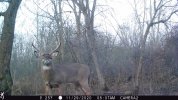In our quest for discovering new, wild, super apple varieties, I remembered while on stand last fall an apple tree I used to bow hunt over. Actually it was a group of about forty apple trees but there was this one tree that every deer would stop at during bow season and it was always a guaranteed Duck-Souper shot if the wind was right. Bow season was during October and I was looking more for late hangers BUT I went just after hunting season last fall to check it out as a possible tree to graft with if it was still holding some apples; Had not been to that spot for maybe twenty years. When I checked the tree (mid December) it was disappointing to see that every apple had long ago fallen and had been got gobbled up. The brush further from the tree was five foot tall but close to and under the tree the brush was completely eaten and flattened. So the tree was still likely a great early tree but not also a late season tree liked I hoped.
However as I looked around and up about five trees away there was a tree so full of apples that it would rival any tree I had ever seen before at any time of year and here it was mid December. I next visited the tree in early February with Ryan from Blue Hill Nursery. The tree had half the apples it had on my mid December visit and Ryan was still Blown away by the amount of apples on it. The tree branches though covered in grape vines and Multi Floral Rose around the drip line were as clean as can be. And the snow was matted down to two inches of ice while the surrounding area had 18 inches of snow. It looked like we had hit the mother load of perfect winter trees. And wouldn't you know it, there was not one usable scion to be found.
That tree and its infinite number of apples haunted me. Mid march (last week) I went back to the tree which Ryan had called All Spurs because there were fruit spurs on every bit of growth including the one year old growth. I was trimming the old suckers out of it and every now and then from high near the thirty ft. top, the trimmings produced a usable scion, tiny but usable. I collected them and will bring most of them to Ryan next week hoping he can duplicate this tree to grow scions and buds to eventually produce a bunch of them. A couple of scions were kept to use here. I'm still new to grafting but I thought I would try a a couple anyway. Here is a picture of one of the better scions. As
View attachment 33964 You can see reproducing this "All Spurs" tree will not be a quick event with a little over an inch of new growth even if everything goes right. All Spurs will be trimmed and fertilized hoping for better scion growth next year. However I'm betting that Ryan will not count on that alone to reproduce this beauty of a tree currently called All Spurs.

![IMG_2068[1934].jpg IMG_2068[1934].jpg](https://habitat-talk-data.xenforo.cloud/attachments/33/33964-92ca1ab330e69d22a0707bc599e10e87.jpg?hash=ksoaszDmnS)
![IMG_2119[1957].jpg IMG_2119[1957].jpg](https://habitat-talk-data.xenforo.cloud/attachments/34/34013-a61f17fc0e796bc254dce9f1716537d3.jpg?hash=ph8X_A55a8)
![IMG_2121[1958].jpg IMG_2121[1958].jpg](https://habitat-talk-data.xenforo.cloud/attachments/34/34014-268169e4adf1ce49603599b3a8aefbec.jpg?hash=JoFp5K3xzk)
![IMG_2116[1956].jpg IMG_2116[1956].jpg](https://habitat-talk-data.xenforo.cloud/attachments/34/34015-5a0f7c4b44e24901e4e53dc9e56c2698.jpg?hash=Wg98S0TiSQ)
